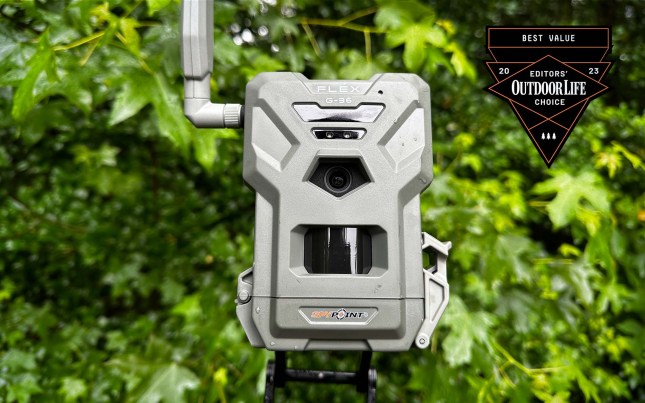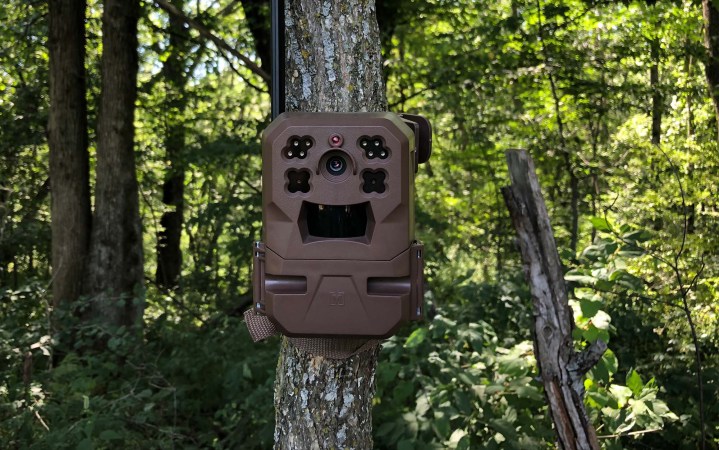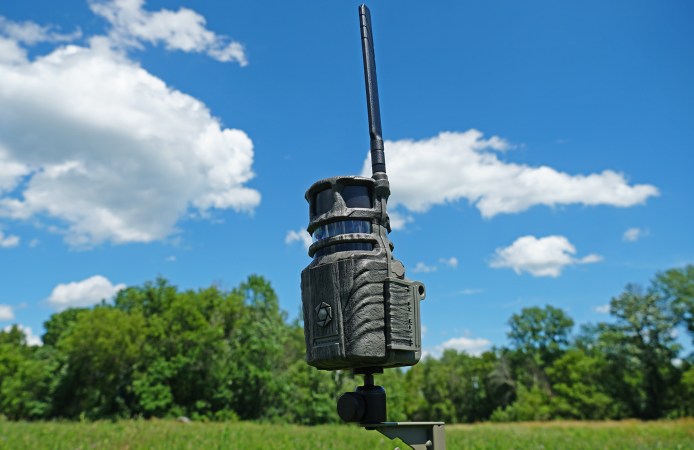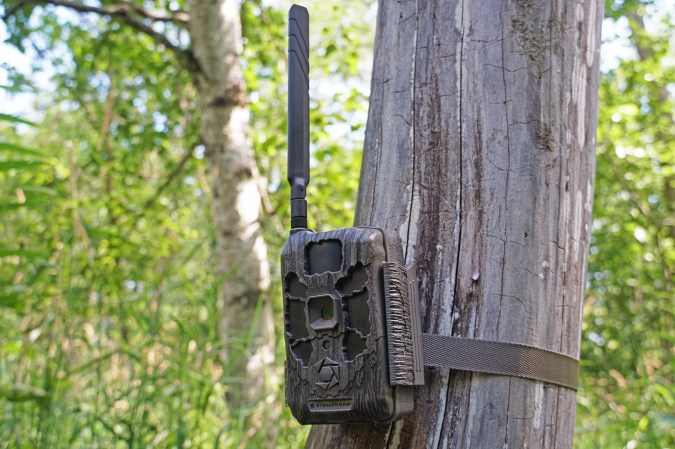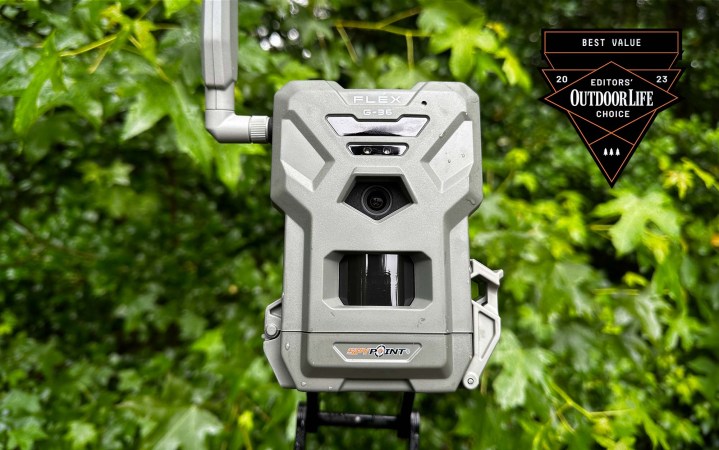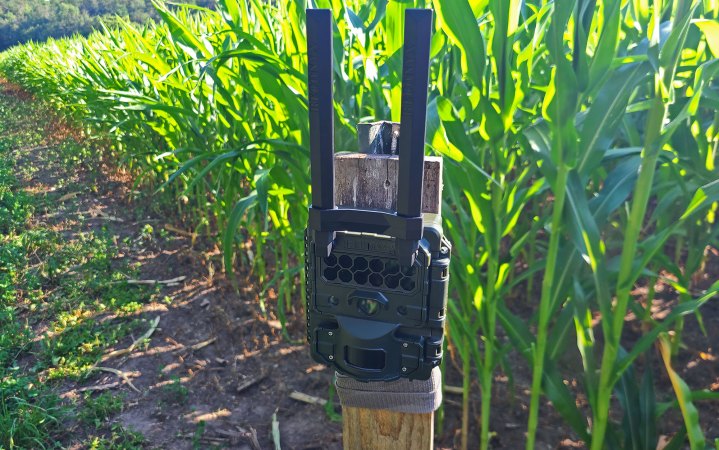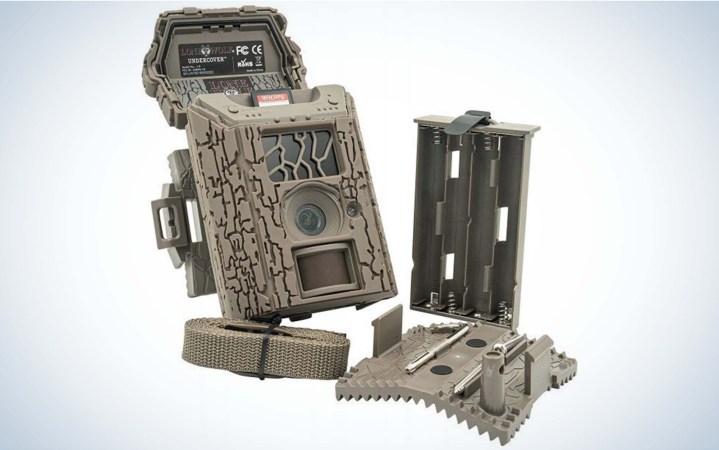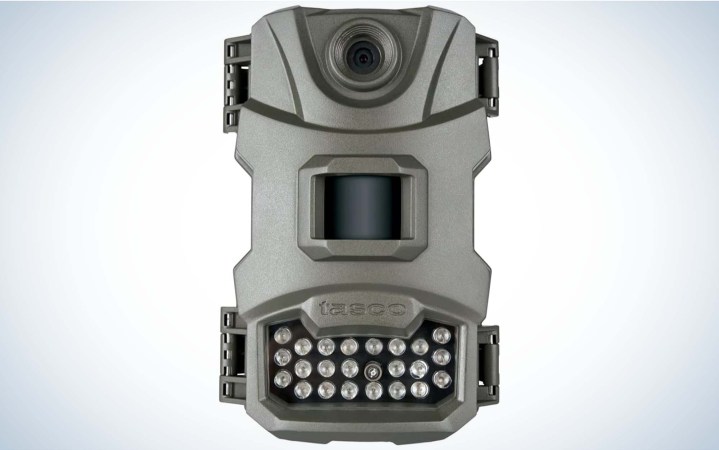We may earn revenue from the products available on this page and participate in affiliate programs. Learn More ›
A lot of hunting gear has reached a performance plateau, but that hasn’t happened yet for the best trail cameras. The new models released this year are more advanced and easier to use than the previous generation. So, if you’re in the market for a new trail cam you’ll be treated to more features, better photos, and more performance for your money than ever before.
For the most part, cellular trail cameras have taken over the market. These cameras pair with apps and send images and videos directly to your phone. There are now several excellent cell cam options in the $100 to $150 range. This is on par with what a decent standard camera costs (but of course, you also have to pay for the data plan with cell cams). That’s why we focused most of our review of the best trail cameras on cell cams.
But not all hunting areas get cell reception and not all states allow the use of cellular trail cameras for hunting. With this in mind, we’ve included two great standard trail camera options.
We’ve also noticed that there’s a growing category of security cam and trail cam hybrids. These cameras promise a live video feed from the woods. In our field testing, however, most of these cameras didn’t perform up to our standards, and only one of them made the cut for this review.
Our trail camera testing really never ends. We’ll continue running these cameras and new additions throughout the fall. In this review, we’ve included both brand-new cameras and the top-performing cameras from previous seasons.
Cell Cams
- Best Overall: Tactacam Reveal X-Pro 3.0
- Most Powerful App: Moultrie Mobile Edge
- Best for Fields and Food Plots: Stealth Cam Revolver 360
- Best Night Performance: Stealth Cam Deceptor Max
- Best Budget Cell Cam: SpyPoint Flex G-36
- Made in America: Reconyx Hyperfire 2 Cellular
Standard Cams
- Best Overall: Lone Wolf Custom Gear Undercover Trail Camera
- Best Under $50: Tasco 12mp Tan Low-Glow
Security Cams
- Best Overall: Ebitcam S40
How We Tested the Best Trail Cameras
Each camera in this review was tested while selecting the best cellular trail cameras and the best budget trail cameras, and represents the top performers from those tests. We put each camera through a consistent test protocol to evaluate trigger speed, detection range, image quality, and reliability. Here’s how we did it.
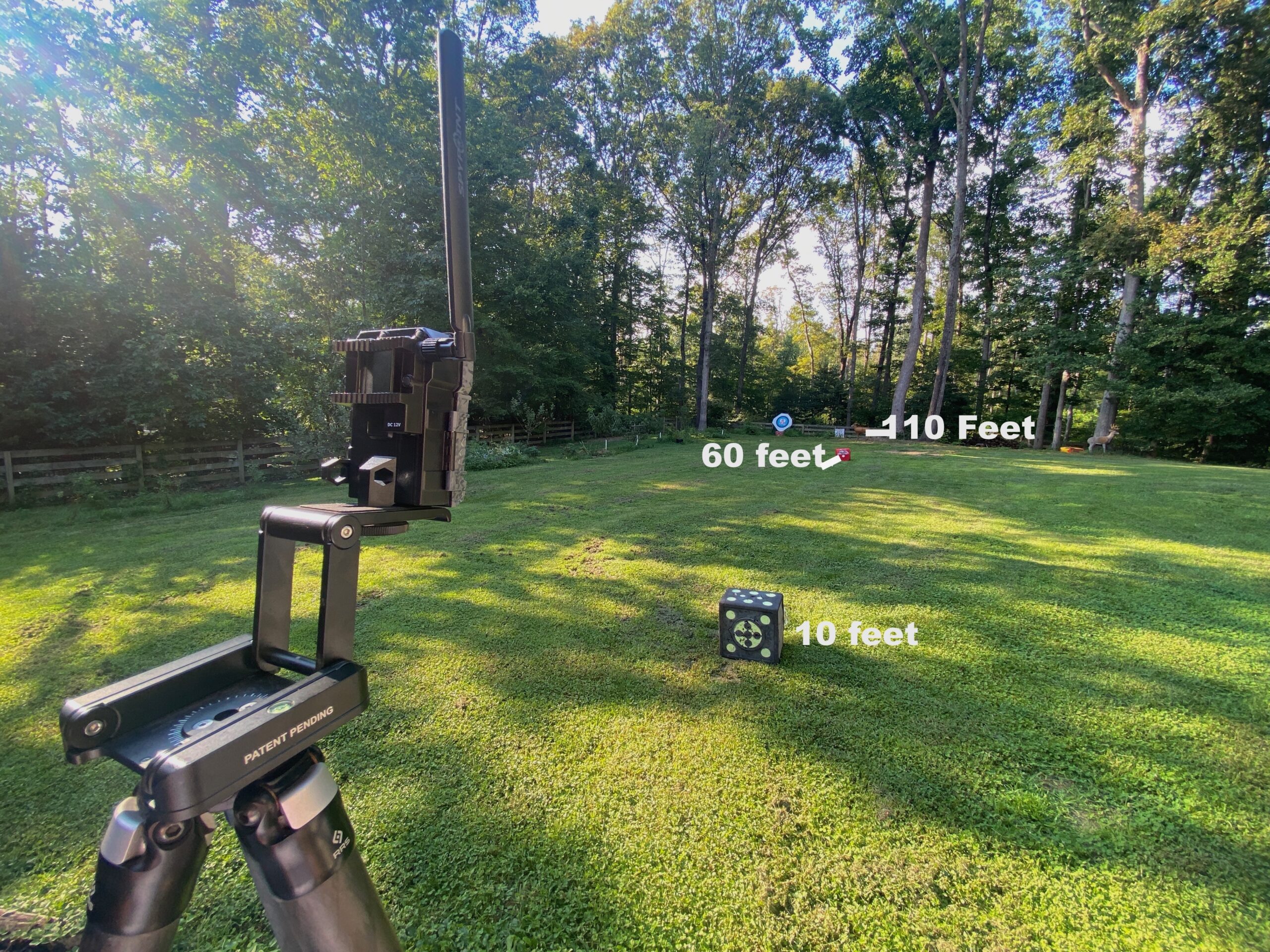
Each cellular trail camera was set to its fastest shooting mode and highest sensitivity. Markers were placed at 10 feet, 60 feet, and 110 feet. The tester walked past the camera (from left to right, then right to left) at a medium pace at each distance. The walkthrough test was then repeated at night. The test is meant to measure the camera’s detection range, trigger speed, shutter speed, and flash range. We looked for blank photos, failures to trigger, blurry images, and overall photo quality.
From there, we set each camera in the field to see how it performed in real-world conditions. In the field, we evaluated the camera’s photo quality, reliability, and ease of setup. This included the ability to use each camera’s app to review and sort photos. Some of these cameras were field tested for an entire hunting season. Others are so new that they’ve only been in the field for a few weeks. We’re constantly testing the latest cameras and will update this review later this fall.
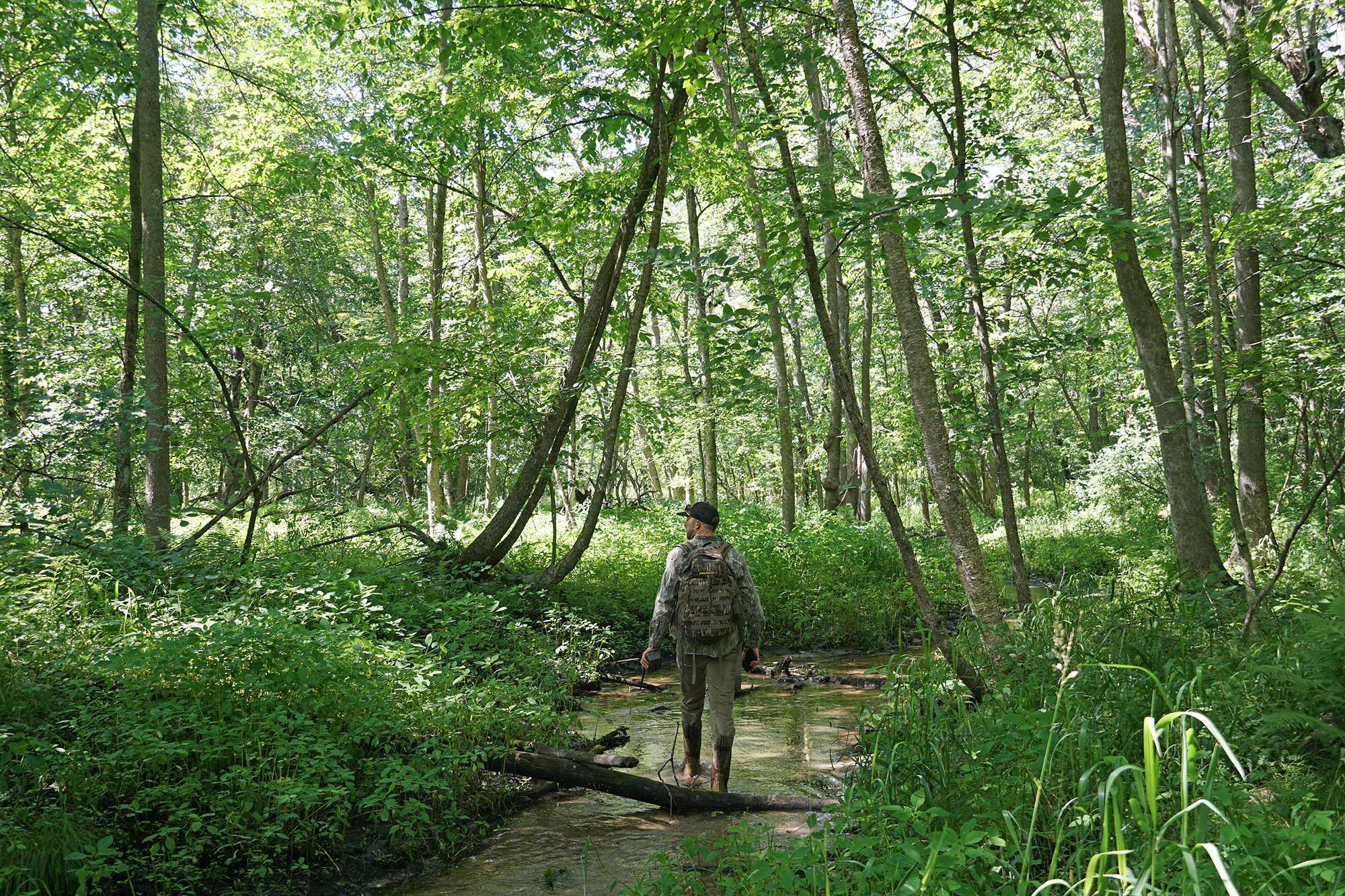
Photo by Alex Robinson
The Test Team and Locations
- Scott Einsmann, gear editor, Virginia
- Drew Palmer, contributor, Kansas
- Alex Robinson, editor-in-chief, Minnesota and Wisconsin
Cell Cams, Reviews and Recommendations
Most of the action in the trail cam world is happening with cellular cameras. There are a ton of cell cams on the market, but we focused on three notable new introductions this year from Tactacam, Moultrie, and Stealth Cam. All of these cameras offer excellent performance at reasonable prices. Realistically, they are not much more expensive than quality standard cameras.
Best Overall: Tactacam Reveal X-Pro 3.0
Key Features
- GPS enabled
- Works on all major cellular networks
- Internal 8GB memory (no need for SD card)
- Pre-installed SIM card
- On-demand video
- Live aiming via app
- 2-inch LCD screen
- No-glow flash
- 80-foot advertised flash range
- 5-shot photo burst mode
- 1080P Video
- No-glow IR
- 1-year warranty
- Price: $155 (plans start at $5 per month)
Pros
- Excellent photo quality and field performance
- On demand photo and video
- Automatically pairs with strongest cellular network
Cons
- Mediocre nighttime photo quality
- Delayed “on-demand” video
- Must pull videos from SD card
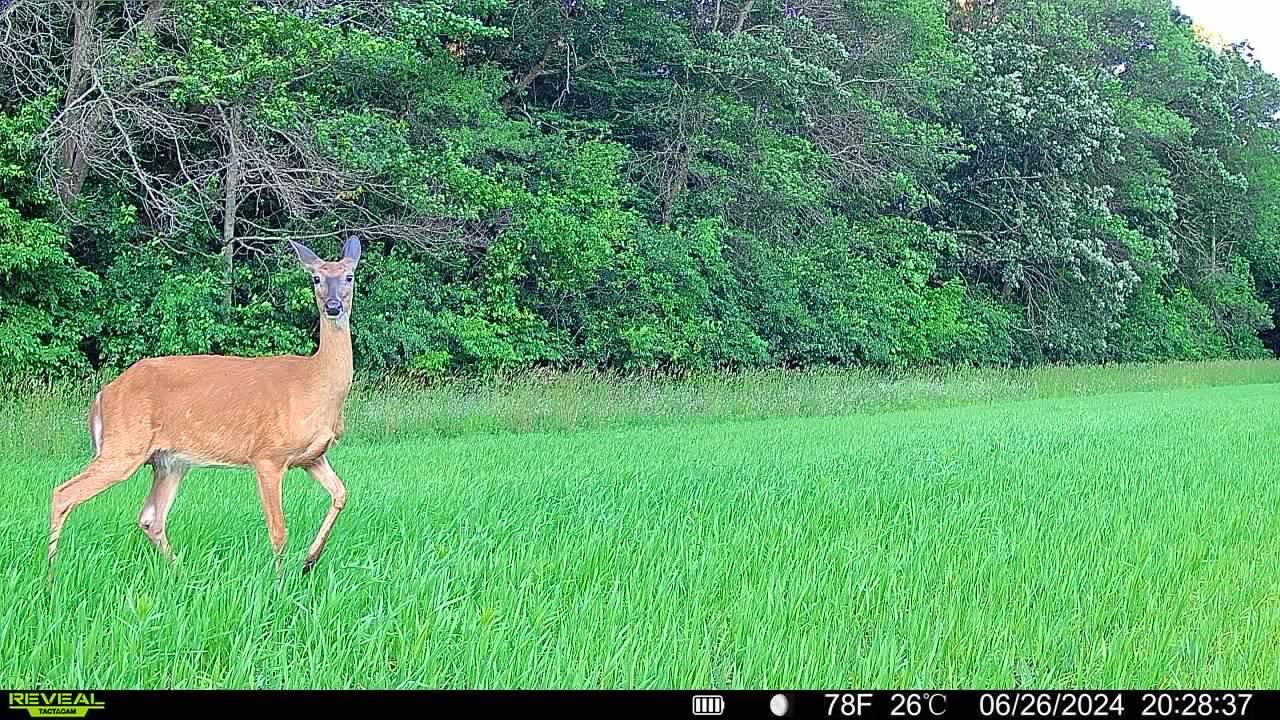
Photo by Alex Robinson
Tactacam’s Reveal trail camera brand is still relatively new to the market, but it has already made a significant impact with reliable cameras that capture high-quality images. This year Reveal is introducing two brand-new cameras: the Reveal Pro 3.0 and the Reveal X 3.0. The Pro version has more features (so that’s the one I field tested), but the X version comes in at a lower price point of only $125.
Just like the previous Reveal cameras we’ve tested, Pro 3.0 delivers excellent photo and video quality. It’s this combination of performance and a host of new features that made it our best overall cell cam pick. First, the new Reveal automatically connects to the strongest cellular network available. Another notable upgrade is the camera has 8 GB of onboard memory and a pre-installed SIM card. This means you don’t have to mess with SD cards, although you can choose to use a card if you like (there’s still a slot for one). With the internal SIM card, the camera will update its firmware through the cellular network. The sexiest upgrade for this camera is the addition of on-demand video. In the Reveal app you select your camera and then select “request on demand video.” The camera then records a 15-second video and sends it back to your gallery. It’s worth pointing out that it took about six minutes from the request to the time the video was viewable in the app, even with three bars of service. So this is not a real-time video feed.
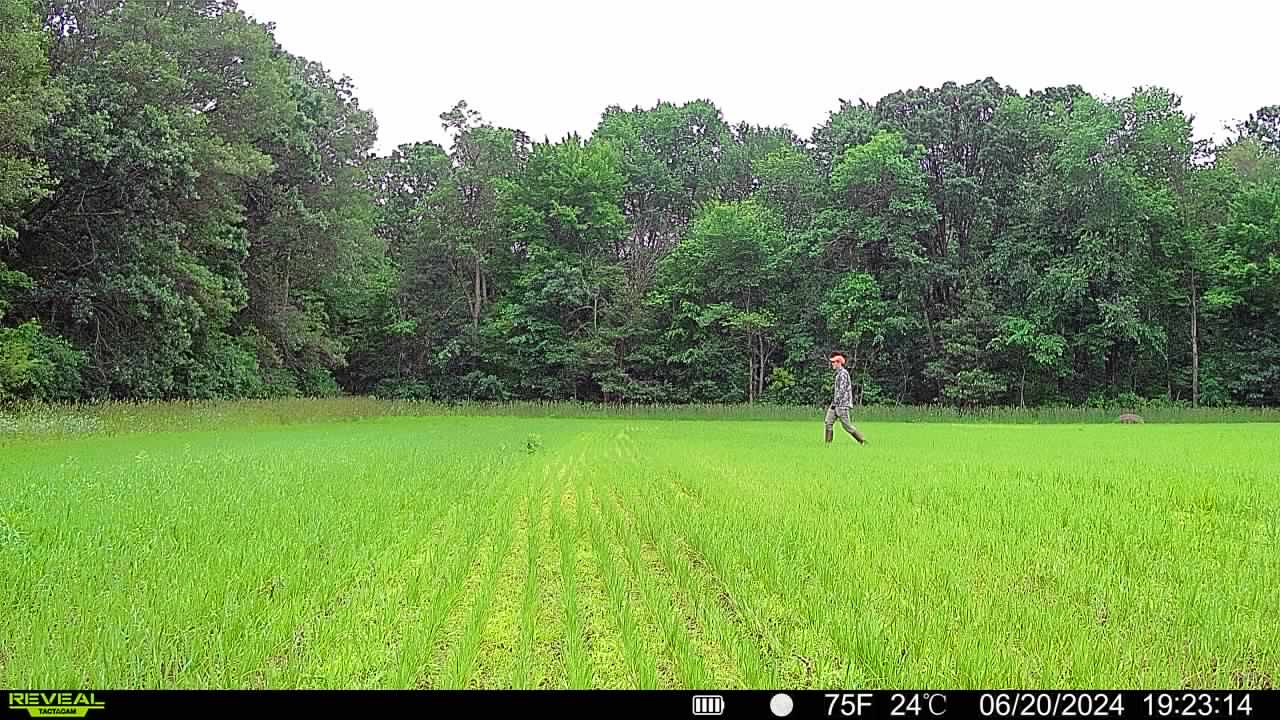
Photo by Alex Robinson
During the walkthrough test the camera triggered at all ranges, day and night, but it did not produce a useful nighttime photo at 110 feet. With the no-glow feature, the Reveal Pro 3.0 has a more limited nighttime range. If long-distance nighttime photos are important to you, consider the Reveal X 3.0 camera, which has a farther flash range.
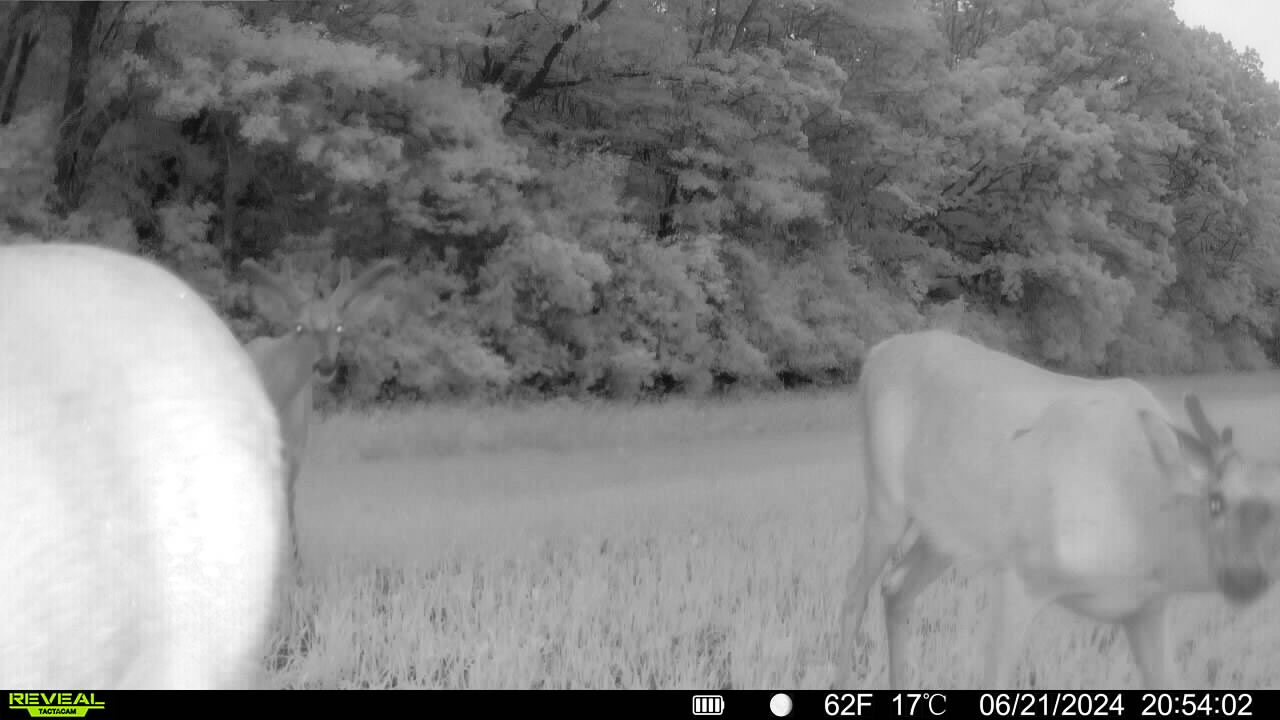
Photo by Alex Robinon
The only other ding I have against the new Reveal Pro 3.0 is that you must pull video clips from the SD card if you’re using one (this excludes on-demand videos, of course). It doesn’t send videos through the app. Read my full review of the Tactacam Reveal Pro 3.0 here. —A.R.
Most Powerful App: Moultrie Mobile Edge
Key Features
- Automatically pairs with most powerful cellular network
- 0.85 second trigger speed
- Advertised Detection Range: 80 feet
- Free unlimited cloud storage
- Internal memory (no SD card)
- SmartTags for species and buck recognition
- 16 AA Batteries
- Price: $80 (plans start at $9.99 monthly)
Pros
- Powerful app with lots of features
- Easy setup
- Affordable for a cell cam
Cons
- Slightly slower trigger speed
What’s truly remarkable about Moultrie’s cellular trail cameras is all of the features they bring to the table through the Moultrie Mobile app. The Edge automatically connects to the strongest network in the area (without requiring you to switch sim cards) and promptly sends photos to your phone. Here’s the cool part: The Moultrie Mobile app is designed with image recognition, so it identifies deer (including bucks vs. does), turkeys, vehicles, and humans in photos. From there, you can sort your photos based on a variety of filters to put together patterns of the deer in your area.
For example, in summer 2022, I hung my test camera on a cornfield edge in a core area of our hunting property in Wisconsin. I ran the camera continuously all fall without issue. It consistently snapped photos of deer and captured me and my hunting buddy anytime we walked or drove by.

According to the app, the highest buck activity for this site was 6 a.m. (I looked through the photos manually to confirm that the app was correct, and it was). Besides time of day, the activity data also accounts for temperature and moon phase. If you’re a serious deer hunter, I’m sure you already see the incredible possibilities for this technology. With several cameras running on a hunting property over the course of several seasons, you’ll have a powerful data set showing when bucks are moving based on time of season, time of day, temperature, and moon phase. I ended up killing my biggest archery buck that season just a few weeks after we caught him on the Moultrie cam.
As a new development, Moultrie has introduced its Game Plan feature. This feature aggregates data from Moultrie cameras in your region to predict deer movement over a one-day, three-day, or nine-day period. It’s essentially like those old-school game activity charts except the intel is based on actual camera data from your area, so it has the potential to be a much more accurate prediction. It’s important to note that Moultrie does not share individual users’ data (in other words no one is going to see your photos or camera locations).
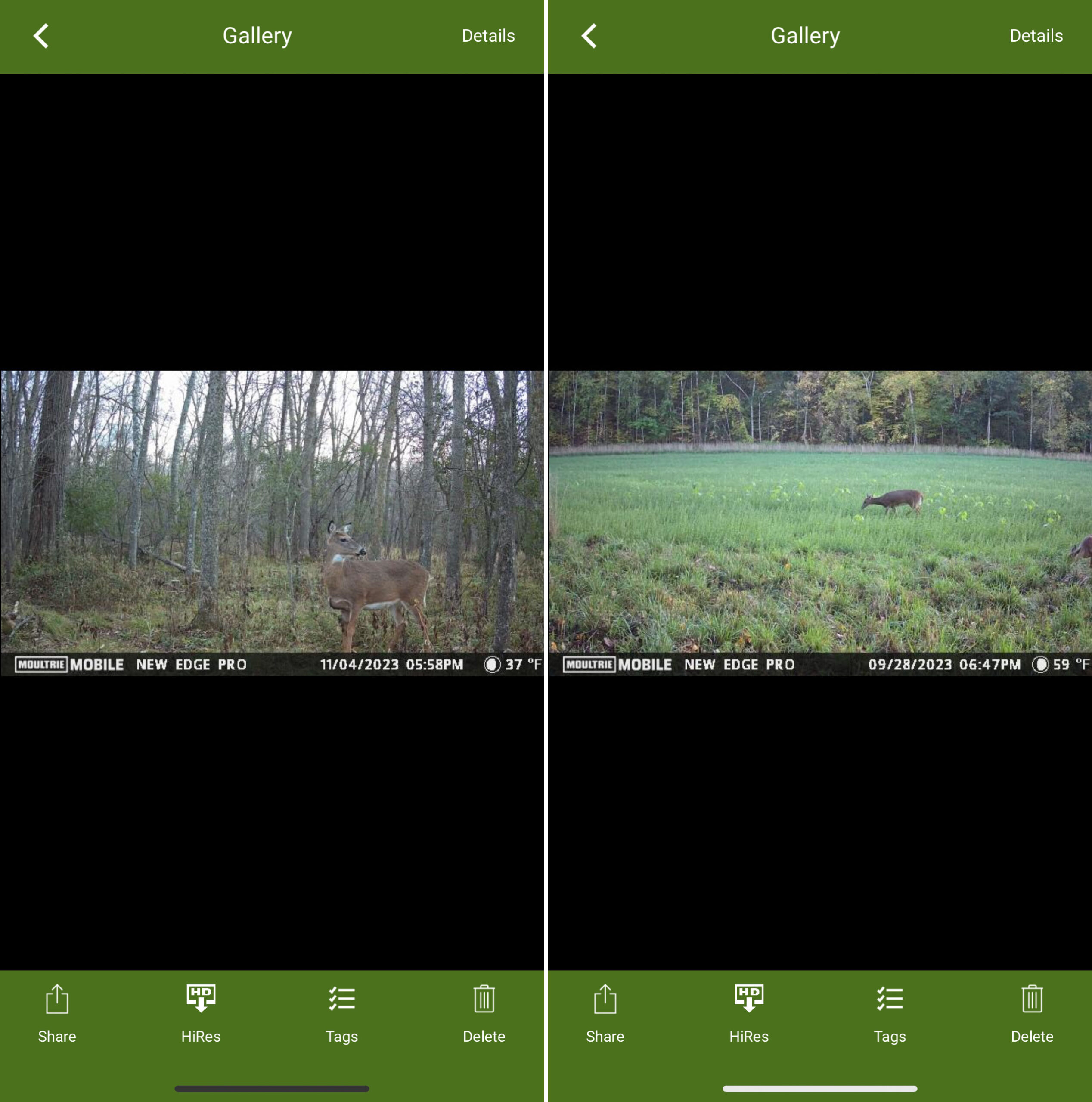
Interestingly, the Moultrie Mobile app has a lot of mixed (and negative) reviews in the App Store as many users seem to have problems with it crashing early on. I’ve been using the updated version this spring and summer, however, and have not had any issues.
In terms of cameras, Moultrie is about to drop its Edge 2.0 and Edge Pro 2.0 cameras. Compared to the original Edge cams, these new cameras boast improved trigger speeds, on-demand photo and video requests, and upgraded photo quality. During the walkthrough tests the 2.0 Moultries did a better job of capturing me at close and far distances. Nighttime image quality was better, too. So if you’re not in a rush to buy your cell cams right now, I’d wait until after July 15, when the new Edge 2.0s drop. Impressively, Moultrie was able to keep the price similar to the old cams (which is to say they’re a solid bargain). But for a scorching-hot deal, you can’t beat a two-pack of original Edge cameras for only $136. —A.R.
Best for Fields and Food plots: Stealth Cam Revolver 360
Key Features
- 6 PIR sensors detect in 360 degrees
- Selectable detection zones
- On-demand photo and video
- Advertised Detection Range: 80 feet
- Compatible with Hunt Stand app
- Automatically pairs with strongest cellular network
- Price: $150 (plans start at $5 monthly)
Pros
- Innovative and useful design
- Covers large areas so you miss fewer deer
- Relatively affordable
Cons
- Mediocre long-range photos
- Requires a little more time to evaluate photos when in 360 mode.
In terms of innovation, this is by far the most impressive trail camera of the year. As the name suggests, it detects and captures photos in 360-degrees. I’ll admit that when I first saw promo material for this cam, I thought that it was gimmicky. But after field testing it for three weeks, I’m a believer. This is the ideal camera to place in food plots, fields, or relatively open natural food sources. Chris Dunkin, the Brand Manager for Stealth Cam, says employees grew tired of having to set multiple trail cameras on a single food plot, so for more than two years engineers have been working on a cam that could detect images and capture photos in all directions.
The result was the Revolver 360 and its magic is all in its design. It has six PIR sensors which detect objects in six different zones. The camera body also contains a small motor that rotates the lens to each of the six zones when triggered. When in “360 mode” you get six photos that the app stitches together to provide a full-circle panoramic scene. This allows you to see what triggered the camera, but also everything else around it. You simply turn your phone sideways to scan the 360 view (see my screen recording below as an example of what you’ll experience in the app).

Now, you don’t need to shoot in 360 mode if you don’t want to. You can instead select the 180-degree mode or a single photo or video mode. In the single photo and video modes, you select which zones you want to be active. If you like, you could select all six zones and still cover 360 degrees with your camera — the difference is that you only get a photo of the zone that was triggered.
This all might sound a little complicated, but it’s actually quite simple. The app is intuitive and after about an hour of working with the camera I felt like I had it mastered. Importantly, the Revolver is also totally capable of capturing good photos in the woods and on trails. In 180-degree mode, it’s a perfect camera for covering logging roads or open trails. In the woods you use a tree mount to set the camera and in fields you use a mounting post.
A notable feature for the Revolver is its on-demand video. The best way to use this feature is to first take an on-demand 360 photo. Then, select the zone you want to view and request an on-demand 10-second video clip. In my testing, it took about three minutes from the time I requested the video to when it arrived in the app.
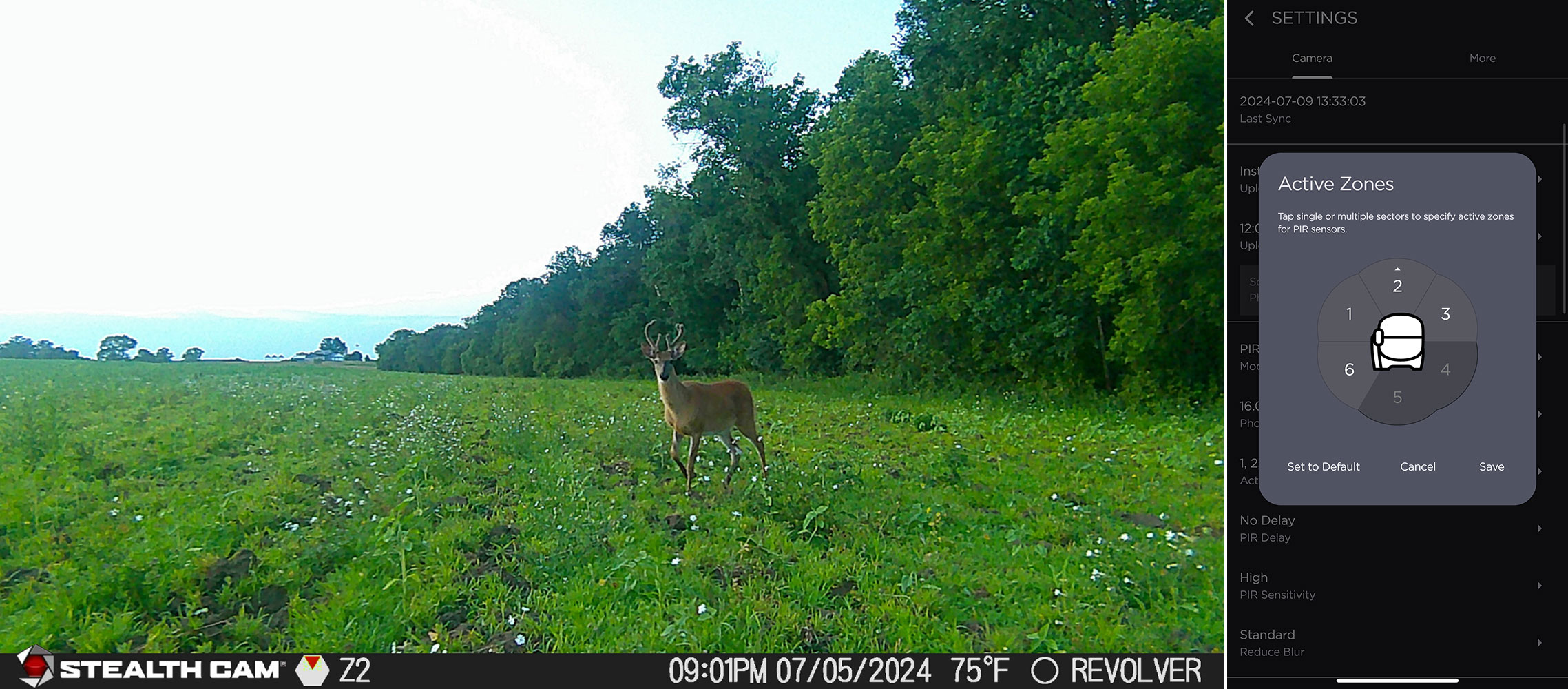
Photo by Alex Robinson
Another nice feature about the Revolver 360 and other Stealth cams is that settings changes happen quickly. The camera recognizes new settings after it sends the next photo. So, if you wanted to change the active zones of the Revolver, that change would take place with the next photo send. Or you can trigger this change immediately by requesting an on-demand photo. Some other cameras don’t implement settings changes for 24 hours.
During the walkthrough test I found that the Revolver camera reliably captured images in all directions at close and medium distances. The only place it struggled was at the 110-foot mark (it only has an advertised detection range of 80 feet, so this wasn’t a surprise). But since it can detect movement in all directions, the actual area that this camera covers is much larger than any other cam in the test. The only other downside is that the 360 mode photos take a little more time to evaluate. Because each trigger results in six photos, it takes you extra time to identify bucks when scrolling through the gallery. But still at $150, this camera is a helluva deal. —A.R.
Best Nighttime Photos: Stealth Cam Deceptor Max
Key Features
- No-glow flash
- 1 to 9 photo burst option
- On-demand photo and video
- Advertised Detection Range: 80 feet
- Compatible with Hunt Stand app
- Automatically pairs with strongest cellular network
- Price: $120 (plans start at $5 monthly)
Pros
- Excellent nighttime photos
- Superb performance in walkthrough test
- Affordable
Cons
- 16MP daytime photos were low quality
If you’re tired of scrolling through blurry, low-quality nighttime trail camera images, you should consider Stealth Cam’s Deceptor Max. Last year the Stealth Cam Deceptor handily won our nighttime walkthrough test. This year, the Deceptor Max delivered Stealth Cam with back-to-back wins. It’s essentially the same camera as last year but upgraded with more battery power (16 AAs). Notably, Stealth Cam will soon be offering a rechargeable battery pack that will really add to the utility of these units.
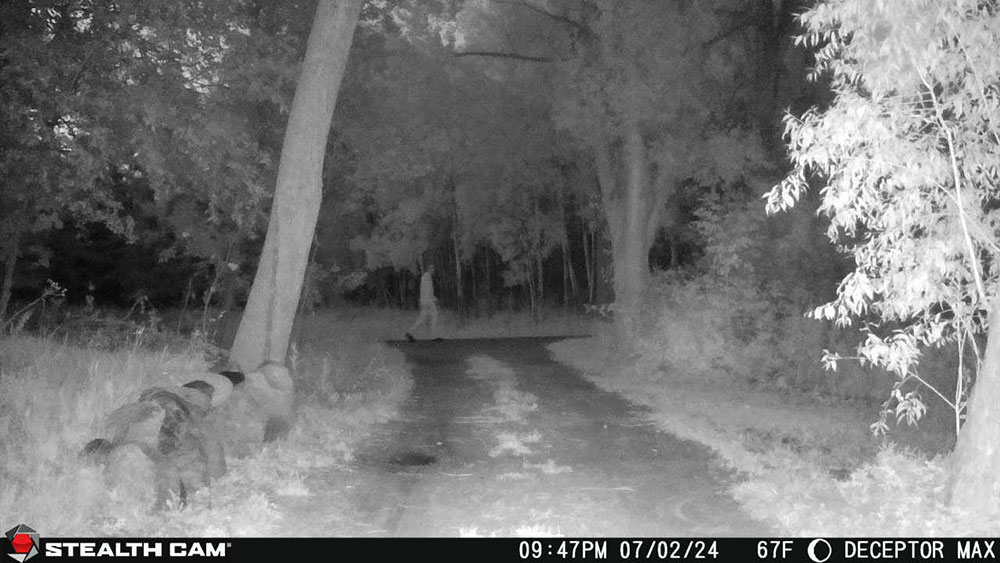
Photo by Alex Robinson
As for nighttime performance, the Deceptor Max captured me clearly at 110 feet, even though the advertised detection range is only 80 feet. It’s the only camera in the test that delivered what I consider to be usable nighttime images at 110 feet. This is extra impressive considering it’s a no-glow camera, so there’s no noticeable red flash when it takes night images. Usually low-glow cameras, which emit a faint red flash, have better long-range nighttime performance. We hung our Deceptor Max deep in a bedding area and tethered it to a Stealth Cam solar panel. The hope is that we’ll be able to run it through the fall without having to reload new batteries.
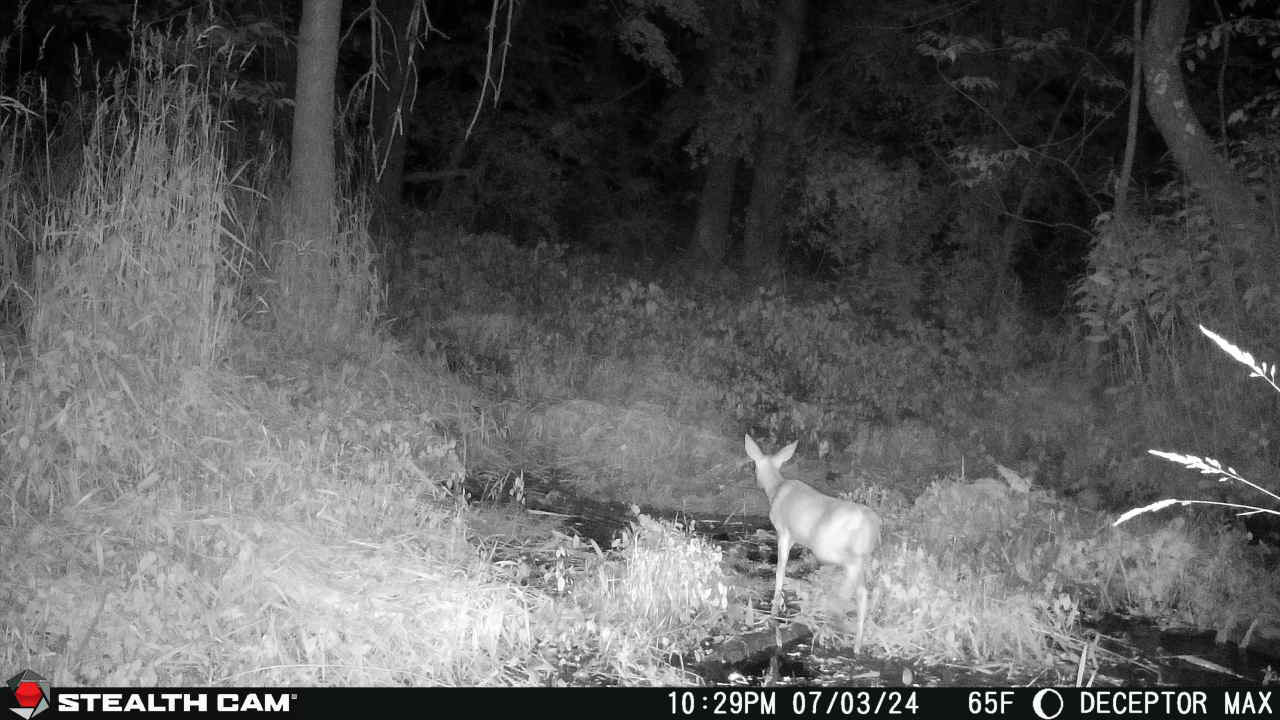
Photo by Alex Robins
Just like the Revolver 360, the Deceptor Max offers on-demand photo and video and quick updates for settings changes. The only downside to this camera is that the 16 MP daytime images lacked luster. In the settings you can bump up to 40 MP photos, but that of course requires more SD card storage space. At $120, I consider this camera a great bargain. —A.R.
Best Value: SpyPoint Flex G-36
Key Features
- 8 AA batteries
- 0.3 second trigger speed
- Advertised Detection Range: 100 feet
- Uses micro SD cards from 2 to 512 GB
- Two-year warranty
- Price: $80
Pros
- Fast trigger speed
- Good flash range
- Detected movement at 10, 60, and 110 feet
Cons
- About a one minute delay between bursts — even on instant setting
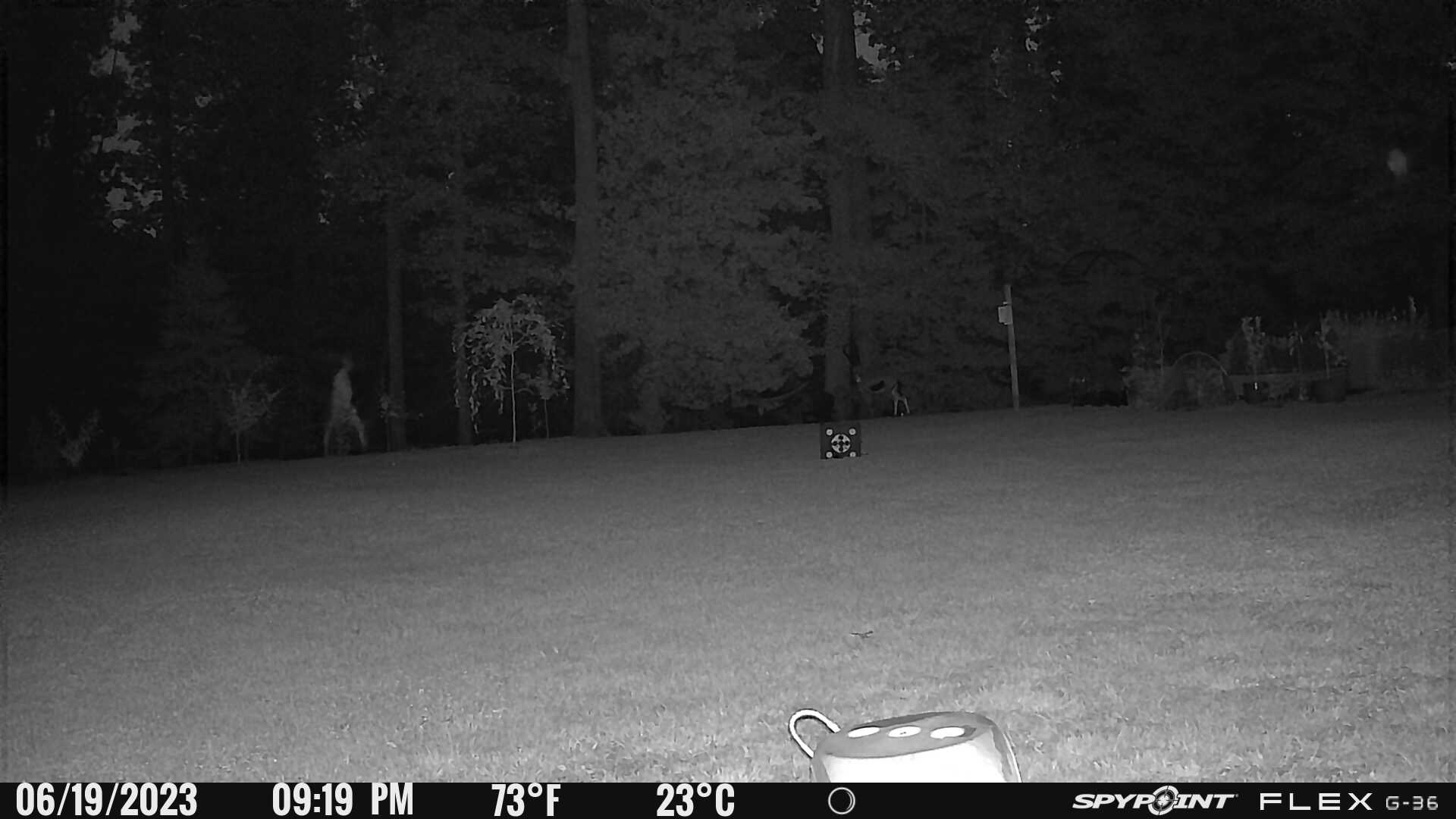
The Flex G-36 improves megapixels and performance over last year’s Flex without a price hike. It costs $100, which is $50 less than the similarly photo-specced Tactacam Reveal X-Pro.
SpyPoint didn’t just give the new Flex G-36 a glossy veneer of three additional megapixels. It gave the trail cam a serious under-the-hood upgrade. Last year, the Flex only triggered at our testing distances of 10 and 60 feet. The Flex G-36 triggered at 10, 60, and 110 feet — day and night. It shot three photos of me in frame at each distance, too.
The photos are crisp with no motion blur, and while the daytime photos are excellent, the night photos are the most impressive. The IR flash is even and reaches far into the night to produce high-detail photos after sunset.
The SpyPoint app is intuitive and easy to use. If you have hundreds of photos you can easily sift through them using the “buck” filter. I’ve used it on my other SpyPoint cameras and it’s not 100 percent accurate, but it’s a quick way to find peak deer activity timeframes.
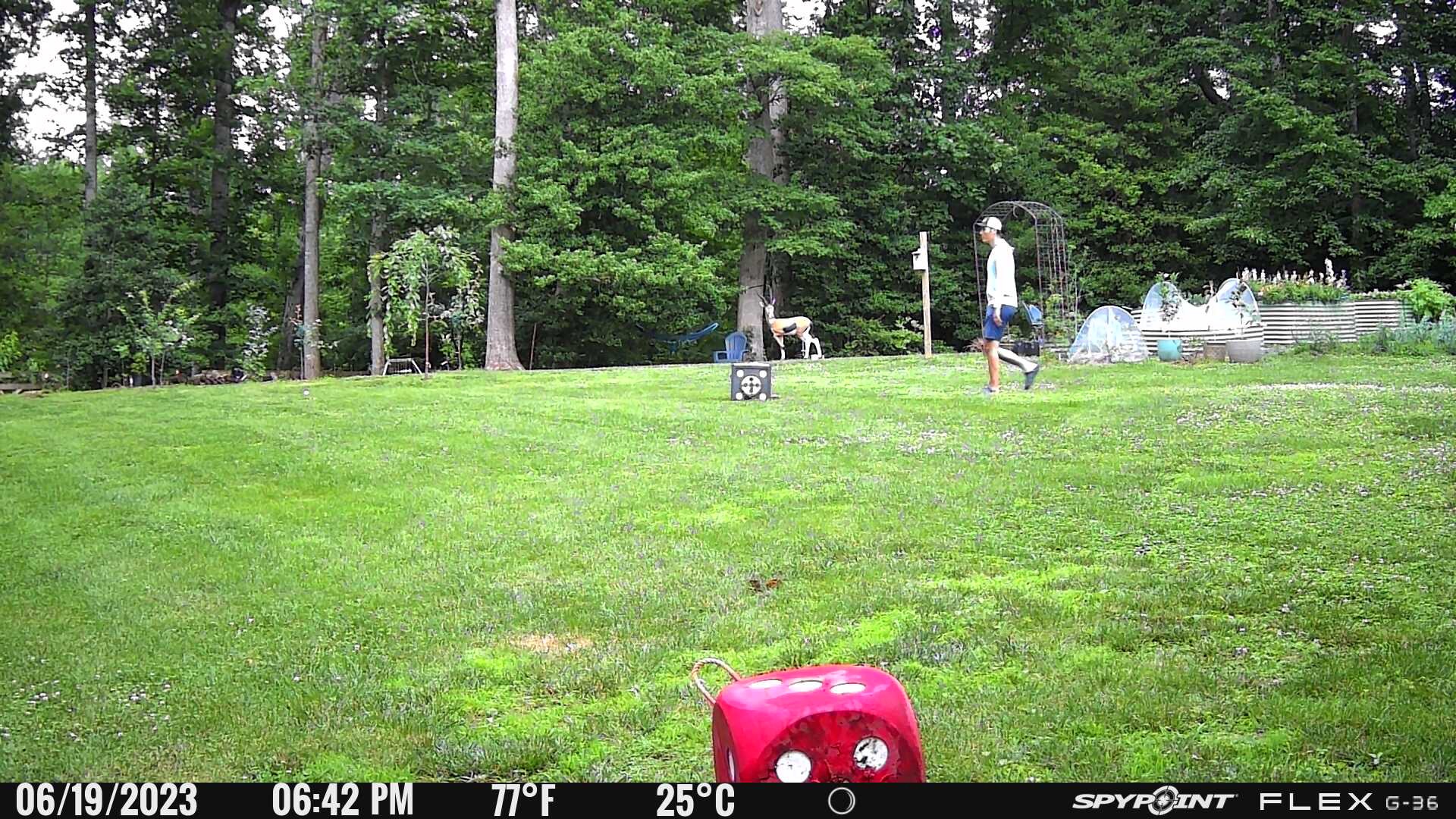
My one knock on the best trail camera for the money is that it takes about a minute to reset between bursts of photos even though I had it set to no delay. In the walkthrough test, I walked from left to right and then right to left. The camera wasn’t capturing my second trip unless I waited about a minute between triggers. That slight delay could cost you a photo of the second deer down the trail, which so often is the mature buck following a doe. But still, for $100 you can’t go wrong with the Flex G-36. —S.E.
Made in the USA: Reconyx Hyperfire 2 Cellular
Key Features
- 12 AA lithium batteries
- 0.2 second trigger speed
- Advertised Detection Range: 100 feet
- Made in the USA
- Five-year warranty
- Price: $600
Pros
- High quality photos and performance
- Excellent warranty and durability
- Fast trigger speed
Cons
- App crashed
- Camera failed in wet weather
- Records video, but doesn’t transmit via cellular network
- Expensive
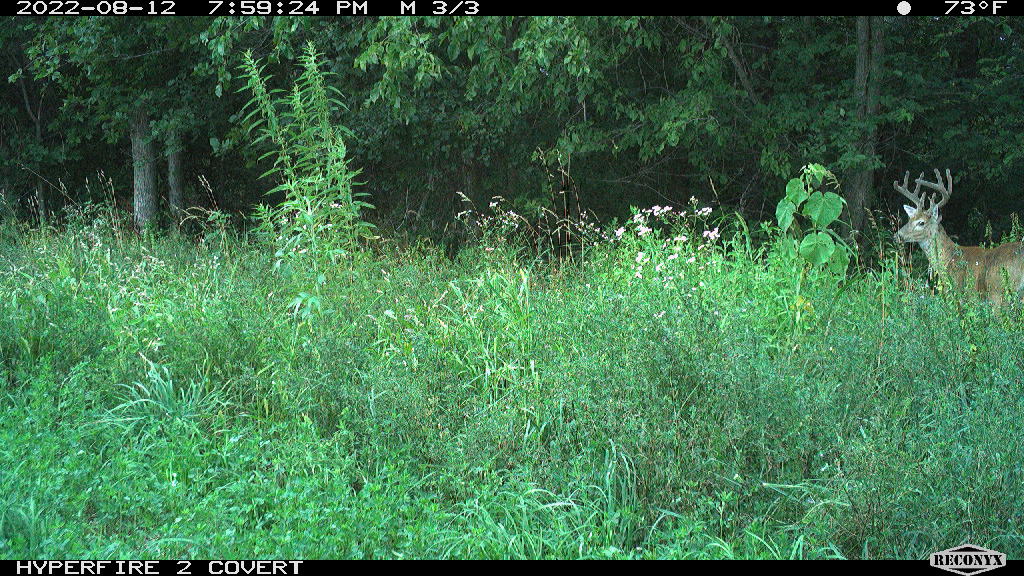
There’s a reason why most professional wildlife researchers who use trail cameras rely on Reconyx: Their cameras are known for reliably delivering high quality images. Hardcore hunters who want that same type of performance lean toward Reconyx, too. This camera performed well in the walkthrough test, triggering out to 60 feet day and night and also catching me at close range. It’s the only camera we tested that’s made in America.
Importantly, it was the only camera that truly stopped motion at close range at night (you can see that image below). The other cameras produced slightly blurry images of me walking close-range at night.

At close range, I could hear other cameras firing, and at night I could see their bright red flashes at 60 feet (the Stealth Cam is the exception here). This was not the case with the Reconyx. There was no visible flash and there was no trigger noise whatsoever.
Surprisingly, I had issues with the camera in the field. First, the app crashed several times when I started using it. I had to delete the app and reload it three different times. In the app store, I saw several reviews with users complaining about the same issue. Happily, all my photos were saved in my profile and Reconyx seems have to solved the issue. Second, the camera fogged up for a few days during the summer. I received several foggy pictures, and when my buddy went to check on the camera, there was a condensation spot inside the housing. We pulled the camera, I opened it up to dry it out, and set it again. The Reconyx went back to capturing clear images. But then a big snow storm hit our area and the camera went down again, with more condensation inside the body.
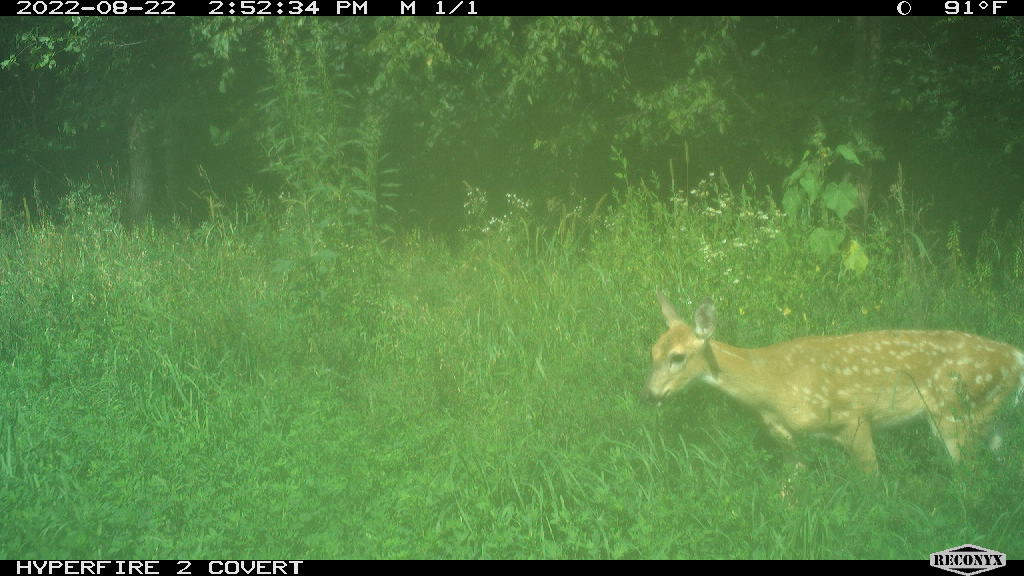
The camera has a five-year warranty, so this would be a fixable issue. I know several hardcore deer hunters who run Reconyx cameras and never have problems. But still, in our testing and review, we had to ding this very expensive camera for its failures in the field. —A.R.
Standard Cell Cams, Reviews & Recommendations
There are still a lot of hunting areas out there that don’t get cell reception. And for those dead zones, standard trail cameras still make good sense. Over the years, two standard cameras have really stood out in our testing — one is a budget option, the other is a high-end model.
Best Standard Cam: Lone Wolf Custom Gear Undercover Trail Camera
Key Features
- Wi-Fi picture retrieval
- 12 megapixels
- 1080p video at 30 frames per second
- 0.4 second trigger speed
- Flash Range: 20 feet
- Advertised Detection Range: 65 feet
- Accepts an SD card up to 32 GB
Pros
- The Wi-Fi transfer system is economical and efficient
- The Ultimate Aim Technology and ball joint bracket make setup easy
Cons
- Battery life is below average
- 12MP photos lack clarity
- The night range is average at best
Lone Wolf came up with a solution to shimming sticks between your camera and a tree to get the angle just right: their ball-joint mount. The Undercover is also one of the few budget trail cameras that can transfer photos to your phone over Wi-Fi with an app. The app can also organize and store photos based on several filters.
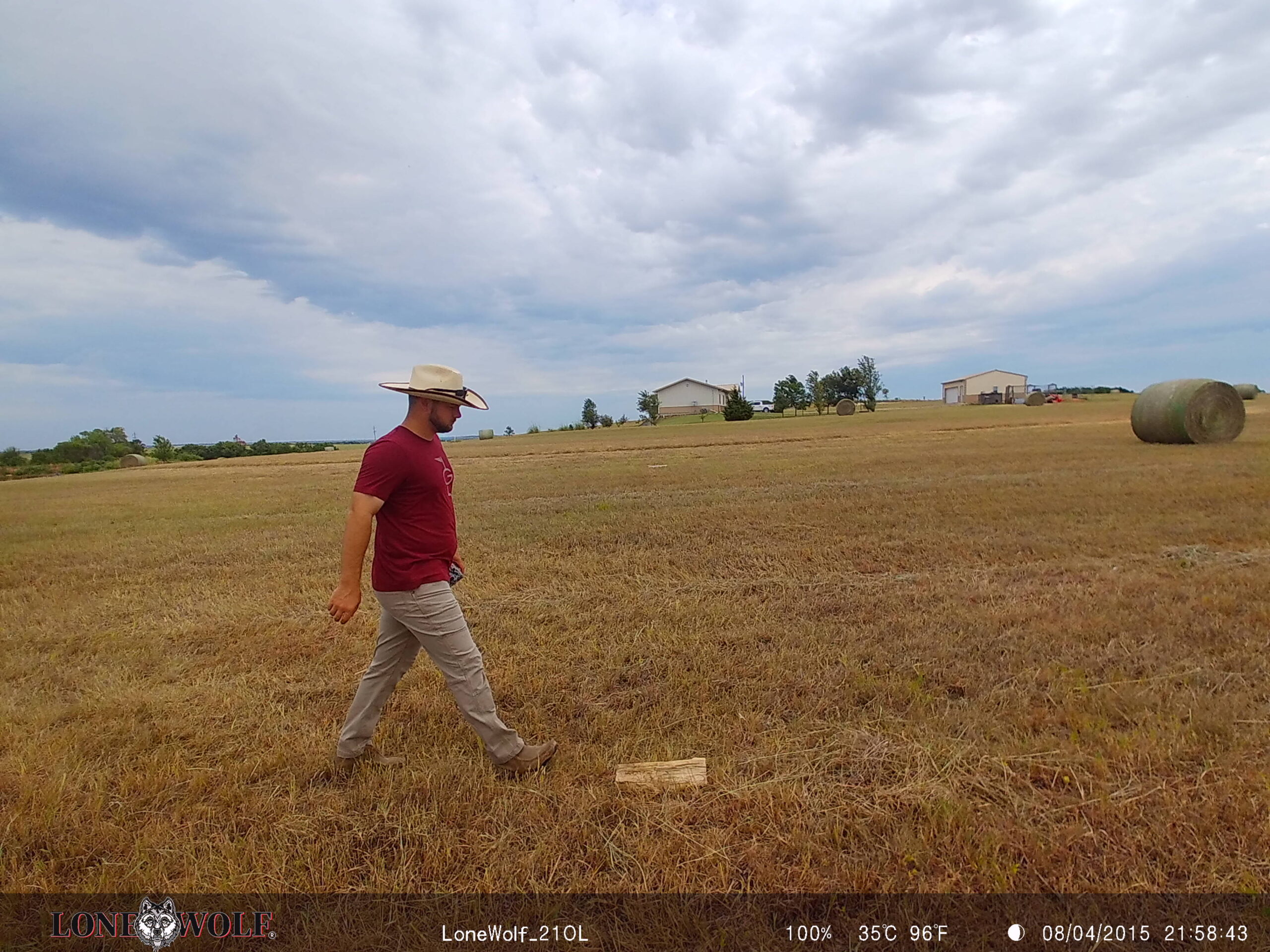
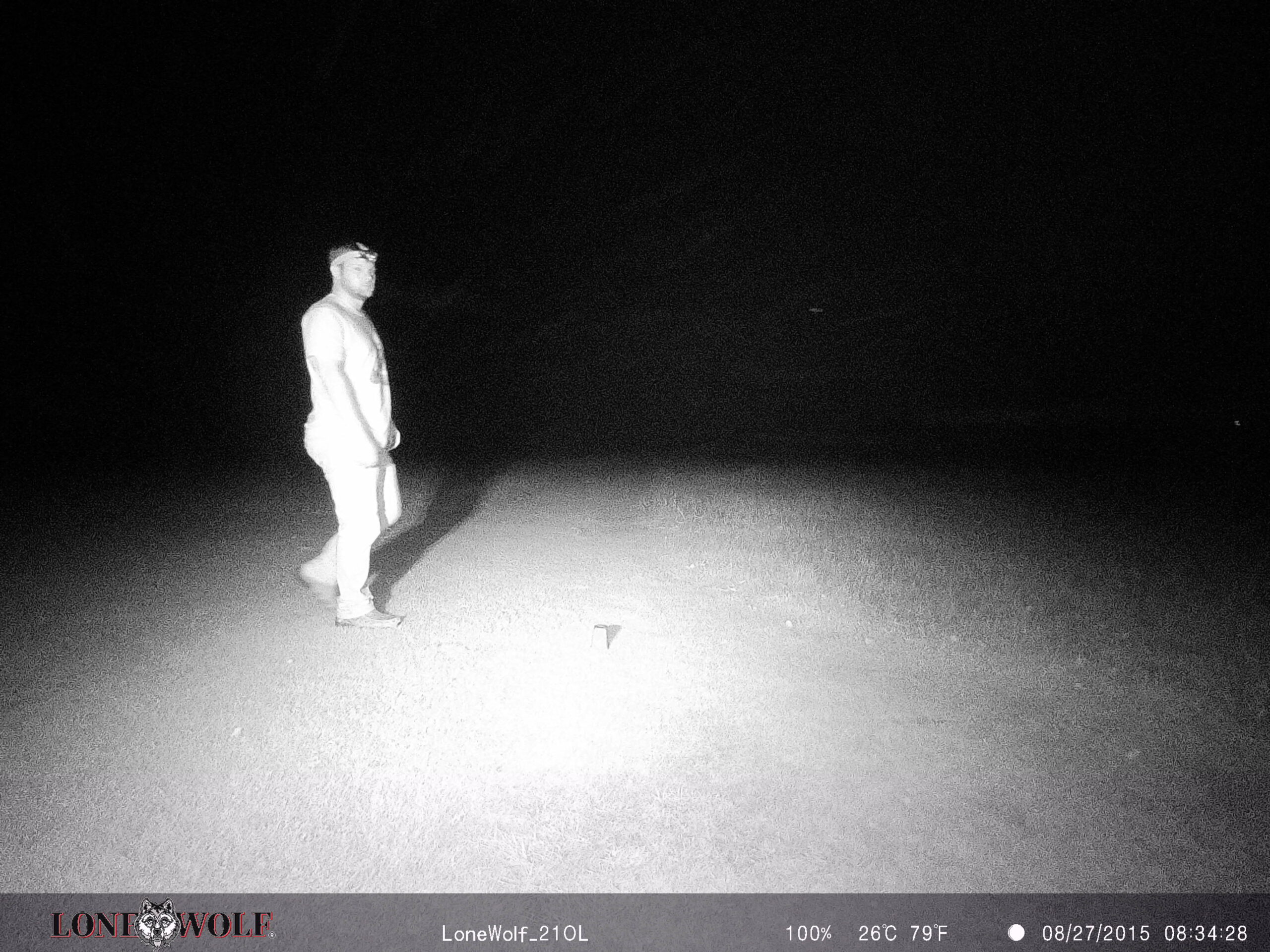
The Undercover’s camera performance was a little disappointing. At 12 megapixels, it’s not going to capture print-quality images for the trophy wall. The battery life on it was iffy past 6,500 images, which is below average compared to many of our other cameras.
The daylight performance of the camera is definitely as advertised with satisfying trigger speeds. It captured me in the center of the frame at the 10-foot distance. The colors were also rich and the image sharp. At night, the camera triggered at 10 feet, but the photo quality was not great. The camera did not trigger at 60 or 110 feet. –D.P.
Best for Under $50: Tasco 12mp Tan Low-Glow
Key Features
- 8 AA batteries
- 12 megapixel images
- 720p video
- 1 second trigger speed, 5 second recovery time
- Flash range: 50 feet
- Price: $50 or less
Pros
- Easy setup with only two options for photo/video
- More than 15,000 images on one set of alkaline batteries
- Cheap
Cons
- Limited function settings
- Can be picky about card sizes/types
- Video lengths can be irregular
I rave to anyone who will listen about these amazing “cheapies.” I’ve had more than 50 Tascos in the field during the past 12 months and haven’t had one issue. The simplicity of this camera makes it fast and easy to set up. It has a one- or three-shot burst mode for photos, and multiple interval adjustments. The only downfall I’ve found is that the videos can be irregular in their length, which cuts off some activity.
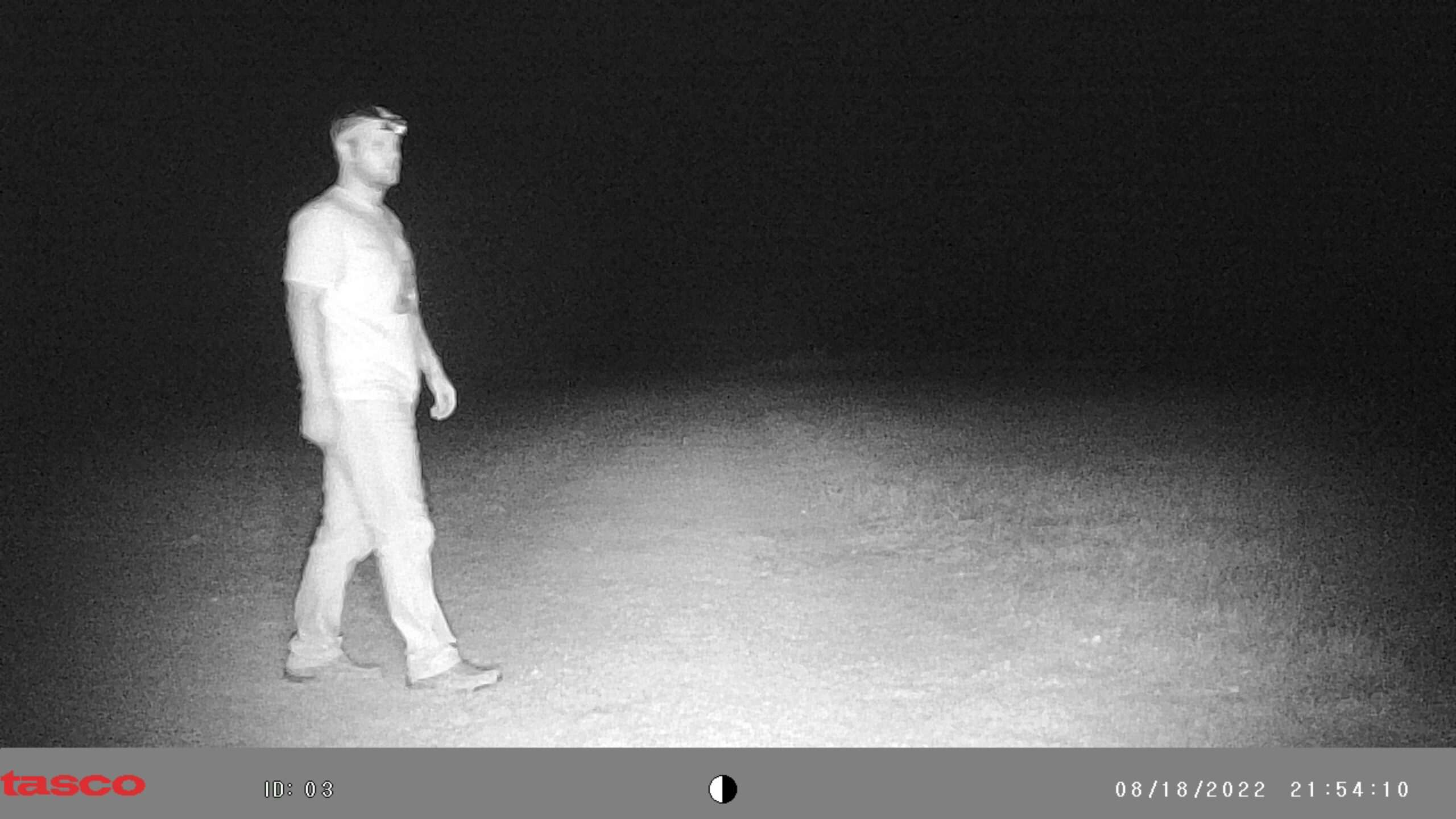
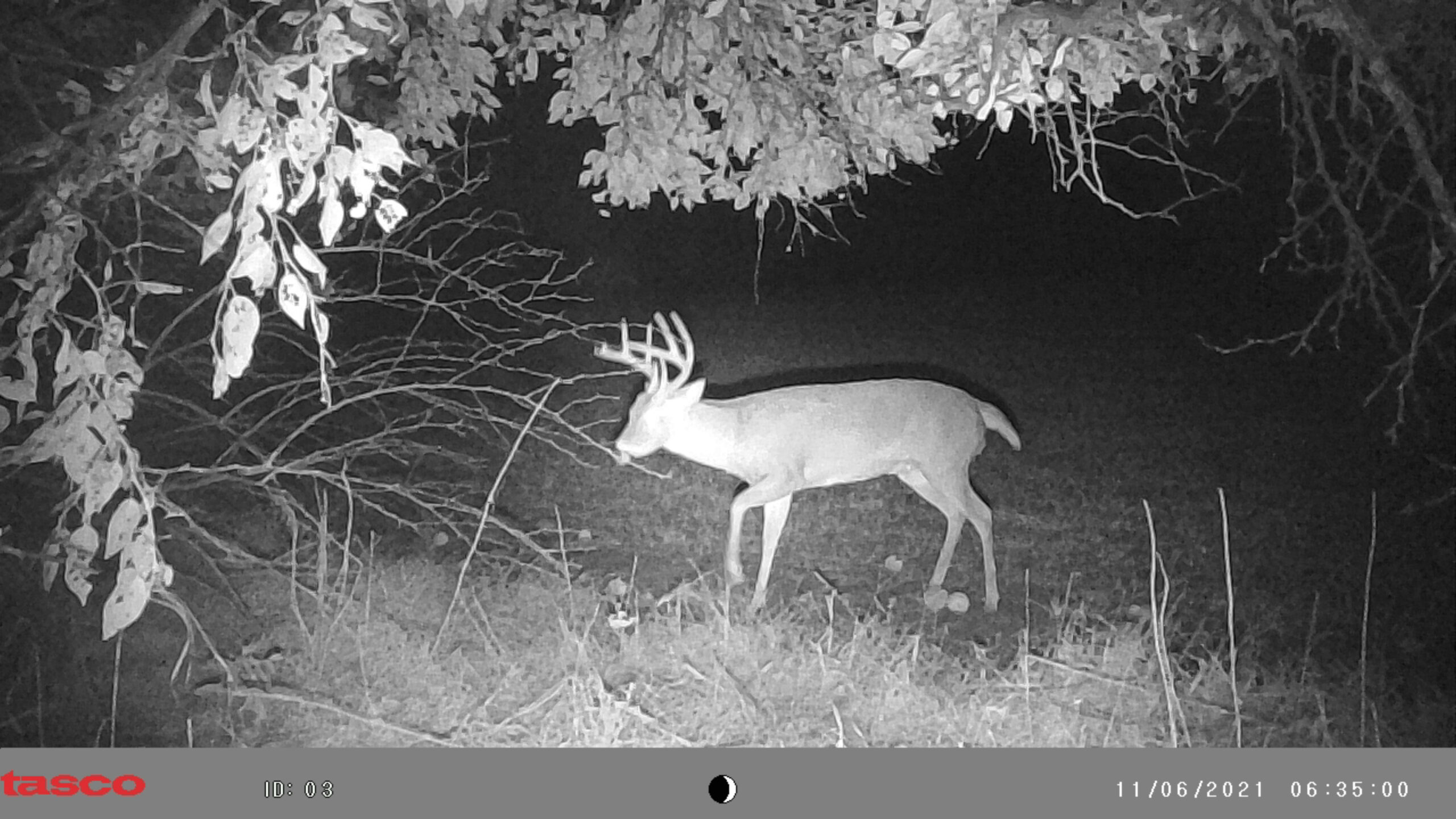
I was truly shocked at the 50 feet of flash range for a budget trail camera. In my walkthrough test it captured me in the center of the frame at 10 feet both day and night. It didn’t trigger at 60 or 100 feet. I operate almost all my Tascos on three-shot bursts, and on several occasions they captured deer running in all three frames. For the price and performance, these are my personal choice for mapping properties and putting patterns together. -D.P.
Security Trail Cameras, Reviews & Recommendations
I tested four of Amazons top-selling security trail cameras, and only one of them worked. Two of the cameras I couldn’t get up and running out of the box, the live functionality didn’t work on the third, and the fourth worked as advertised.
I found that the apps didn’t have the functionality I was used to with name brand trail cameras. It’s pretty obvious that these cameras are being made by people who don’t hunt and don’t understand the features hunters need. The apps are a little sketchy too, and I’m skeptical about who gets access to the data they collect.
For the most part, these cameras aren’t ready for prime time. But, with a little product development they could be the next big trend in trail cameras. —S.E.
Best Security Trail Camera: Ebitcam S40
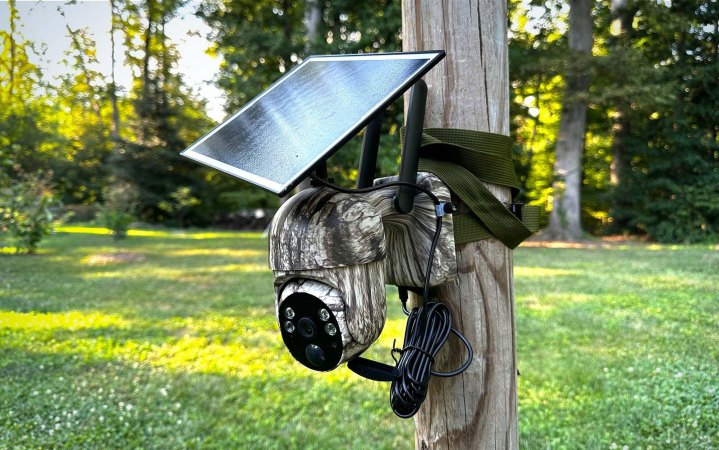
Key Features
- 2K video
- Includes solar panel, SIM card, SD card, and mounting hardware
- Night Modes: IR and white light
- Video only
- Records 10 second clips per trigger
- On-demand video
- Can adjust camera view and settings remotely
- Camera Price: $120
- Cellular Subscription: $14.90 (one month), $79.90 (six months), $229.90 (one year, premium package)
- Cloud Storage: $20.59 (one year), $1.99 (one month)
Pros
- On demand video, white light, and camera adjustment works with just a few seconds of delay
- Triggered consistently at close distances
Cons
- Did not trigger at 60 feet or farther
- Lacks features
- No photo option

This camera has unique features you won’t find in other cell cams. You can view a live stream through the app and move the camera left, right, up, and down. Unlike the other security cameras I tested, this one had just a one- to two-second delay on the live video and adjustment.
In the walk-through test the S40 triggered at 10 feet from both directions day and night, but didn’t trigger at the farther distances. I tried a few impromptu tests to see how far beyond 10 feet it would trigger and 30 to 45 feet seemed to be its max for consistent captures.
I placed the S40 on a travel corridor, and it captured a ton of deer activity. The deer mostly moved perpendicular to the camera on trails 15 to 30 feet away. The video quality wasn’t great overall, and it was especially poor at night. What makes it worse is that the IR light over exposes the image and then adjusts down to a good setting. That blooming effect cost me a clear look at what I think is a stunner buck. One more knock on the night performance is the IR doesn’t illuminate brightly beyond 10 feet. A unique feature is that you can run a white light in video mode for color video. You can also remotely turn on the white light while viewing the live stream.
I think this trail and security camera hybrid has limited use cases for hunting, but in the right scenario it could be an asset. Probably the best use for it is to position it over a feeder. Before you walk into the stand over the bait site, you can turn on the live feed and use the camera panning feature to scan the area. If you’re in a state with hogs, you could use the camera’s white light as a feeder light. —S.E.
How to Choose a Trail Camera
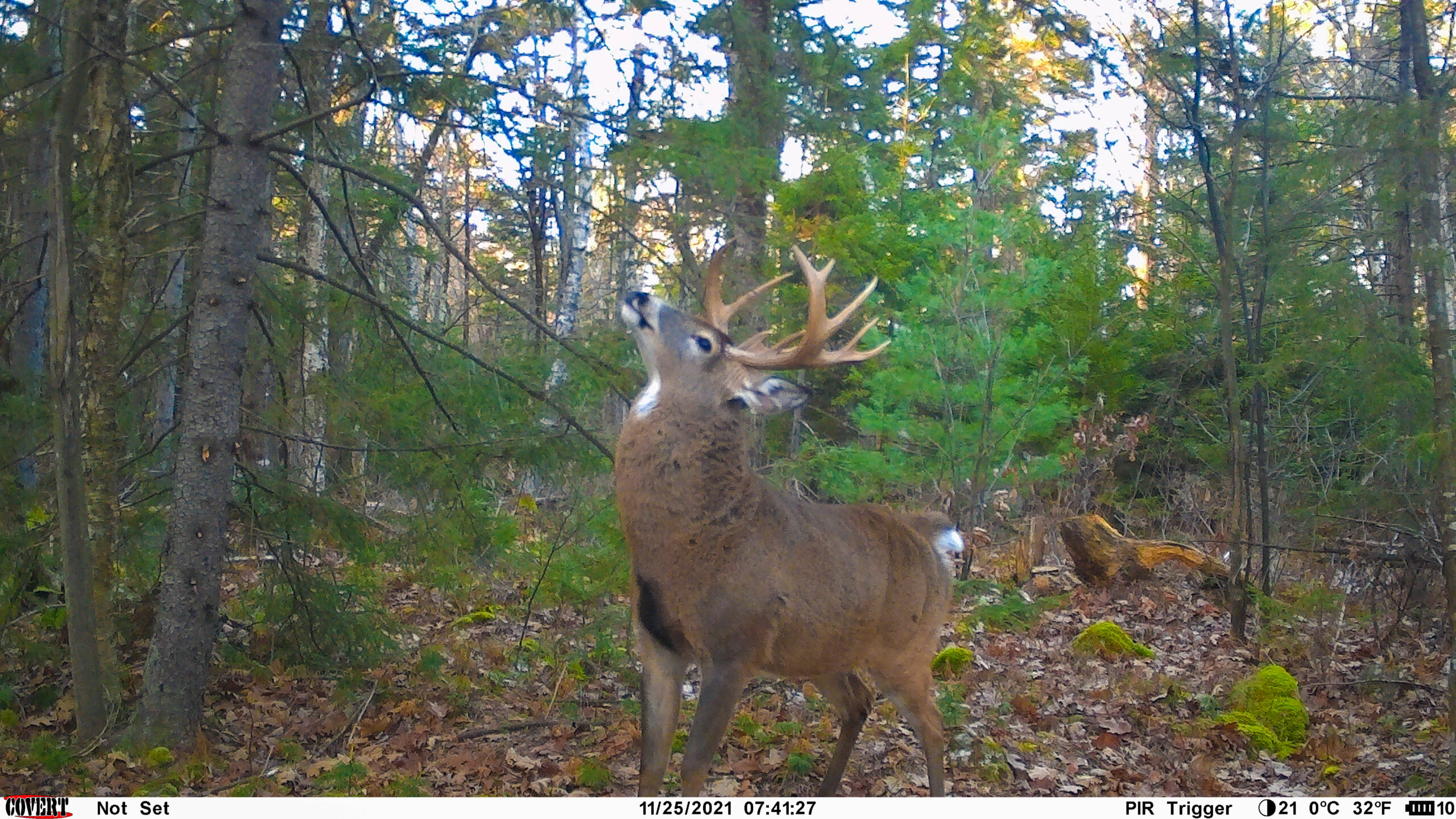
Cell Camera or Standard Trail Cam?
Cellular trail cameras offer the most convenience because you can hang them and leave them in the woods until the batteries die — all while getting near real-time scouting information sent to your phone. That saves time and gas. More importantly you’re not bumping deer and leaving scent by going into the woods to check camera cards. The main downsides are that you need cell service in the location you’re placing the camera, and cell cams come with additional monthly costs. Cell camera plans typically range from $4 to $15 per month, with additional charges for downloading full-length HD videos or hi-res photos. Cellular trail cameras are more tightly regulated with some states allowing standard trail cams but banning the use of cell cams.
Standard cameras don’t have monthly fees and have longer battery life. They also rival cell cams in photo quality. Of course, the main downside is that you have to physically check the cameras, and the data you’re getting is old.
Trail Camera Accessories We Like
- Camera Stand: Stealth Cam Mounting Post
- SD Card: Sandisk Extreme Pro
- Batteries: Energizer Lithium
- T-Post Mount: Moultrie Multi-Mount
- Solar Panel: Tactacam Reveal Solar Panel
- Tree Mount: Stealth Cam Screw-In Tree Mounts
Trail Camera Prices
Just like cameras used for photography a more expensive camera usually produces a better image and has more features. We’ve provided sample photos for each camera to help you see the difference between a $40 Tasco, a $150 Tactacam, and a $600 Reconyx.
Most hunters will either buy the cheapest trail cam and replace it every few years, or buy one in the $100 to $150 range. We’ve found that above $200 you start to lose value for your dollar, and running multiple cameras becomes very expensive. There are now several great cameras in the $100 to $150 range.
Trail Camera Flash: Low-Glow, No-Glow or White Flash
There are pros and cons for each type of camera flash. Here’s a quick and dirty break down.
White Flash
We’ve looked into if trail camera flash spooks deer and after talking to biologists and hunters, several of them prefer white flash and feel it spooks deer less often. They especially like the color images provided by a flash. However, most of the best trail cameras are not offered with white flash.
Low-Glow
Low-glow IR cameras produce a visible red glow from the infrared emitters when they take a picture or video at night. The red glow is typically faint, but can be seen when looking directly at the camera. These cameras typically take superior night images compared to the no-glow cams. Many hunters and experts believe the flash can be detected by deer.
No-Glow
No-glow cameras like the Tactacam and Stealth Cam have black filters over the infrared emitters to hide the red flash. These cameras are sometimes described as black flash cams. No-glow cams are much less likely to be detected by deer or humans at night, but they typically produce lower-quality nighttime images. However, Stealth, Tactacam, and Reconyx have proven to be exceptions to this rule.
Read Next: Best Deer Attractants
Cellular Trail Cameras and Hunting Ethics
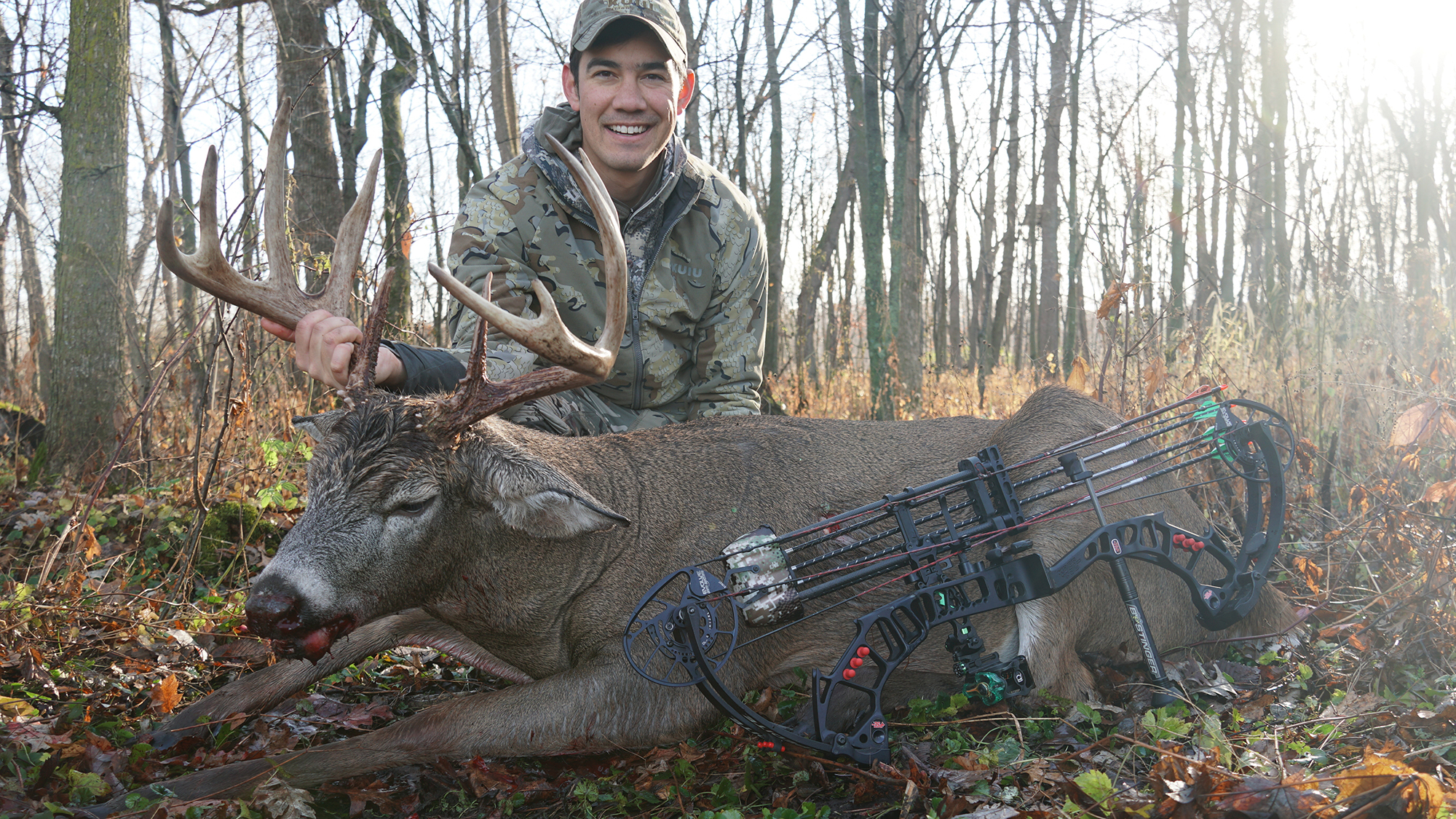
There is some controversy in the hunting community about using cellular trail cameras to hunt big game (make sure to check your local regulations before buying and using a cellular trail camera). In 2022 the Boone and Crockett club revised its policy in regard to cell cams, stating: “The use of any technology that delivers real-time location data (including photos) to target or guide a hunter to any animal in a manner that elicits an immediate (real-time) response by the hunter is not permitted. ‘Real time’ is the key concept. Seeing a photo and harvesting an animal a few hours later, or even the same day, uses this technology to assure a kill. It also takes advantage of the animal, which cannot detect impending danger from a camera. Waiting several days, or even until the following season, to pursue an animal captured on camera is different, and would not be deemed an unethical use of a trail camera.”
Right now, I don’t see many hunters using cell cams to capture images of a buck on a food plot or corn pile and then running out there to kill him that moment. As live-feed video in cellular trail cam technology becomes more advanced and wide spread, however, it could be come a problem for fair-chase standards. More states will likely look to restrict the use of this technology for hunting. It’s up to hunters to use the tech responsibly. At their best, trail cams can provide consistent data on deer movement and hunters can interpret that data when making decisions on where to hunt. Most of us have limited days to hunt, so picking a prime spot is critical. But we must still use our woodsmanship, hunting knowledge, and fair chase principles. I think the best trail cameras can only help with that. —A.R.
Cell Cams
- Best Overall: Tactacam Reveal X-Pro 3.0
- Most Powerful App: Moultrie Mobile Edge
- Best for Fields and Food plots: Stealth Cam Revolver 360
- Best Night Performance: Stealth Cam Deceptor Max
- Best Budget Cell Cam: SpyPoint Flex G-36
- Made in America: Reconyx Hyperfire 2 Cellular
Standard Cams
- Best Overall: Lone Wolf Custom Gear Undercover Trail Camera
- Best Under $50: Tasco 12mp Tan Low-Glow
Security Cams
- Best Overall: Ebitcam S40
Final Thoughts on the Best Trail Cameras
With modern trail camera technology, we don’t have to guess if deer are in the area or what time they’re moving. When used consistently, trail cams can paint a vivid picture of deer activity patterns in your area. But trail cameras are also notorious for malfunctioning, bugging, and dying in the field. So if you want to get serious about patterning the deer you hunt, do yourself a favor and get one of the best trail cameras available. Actually, get a few of them.


